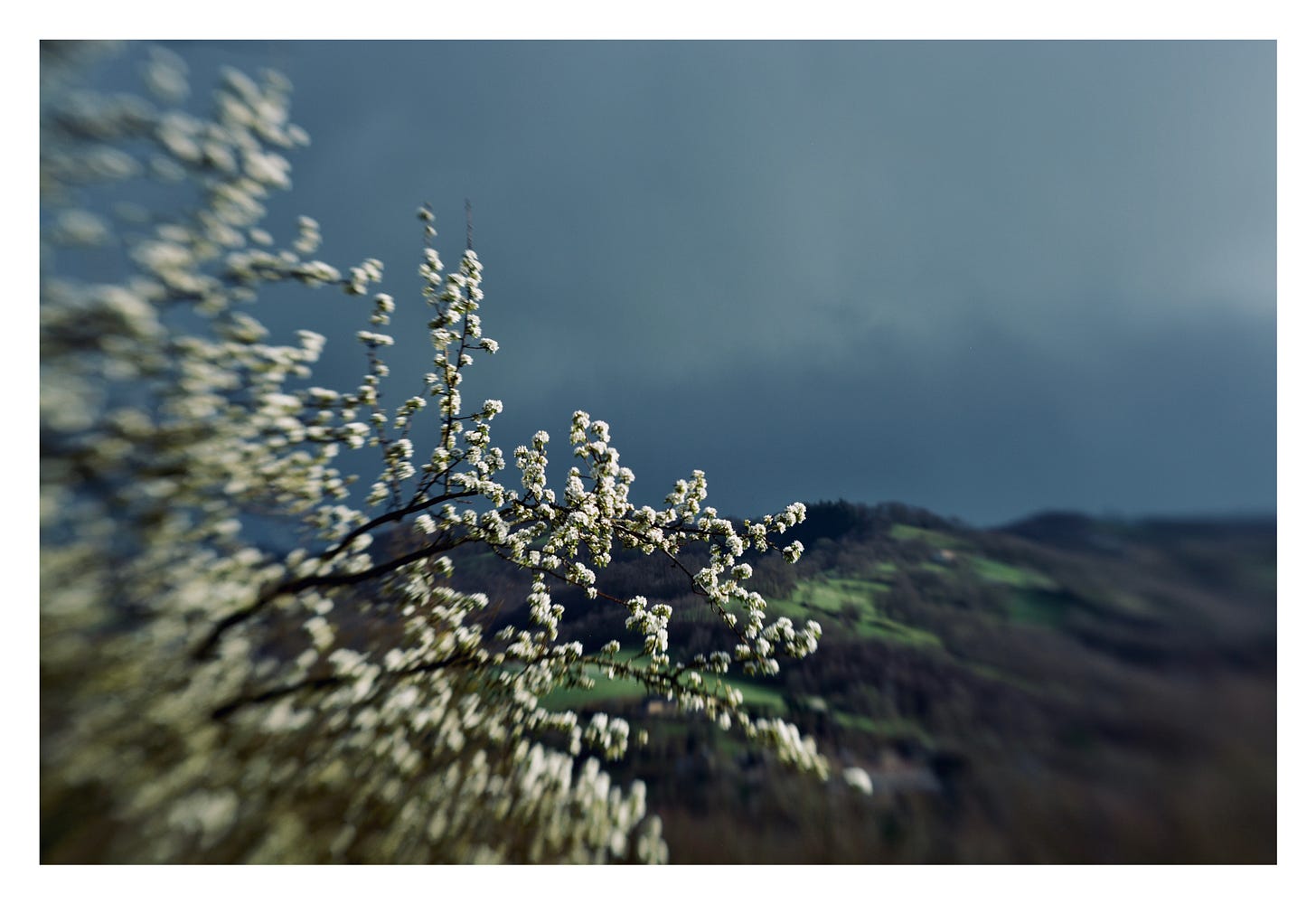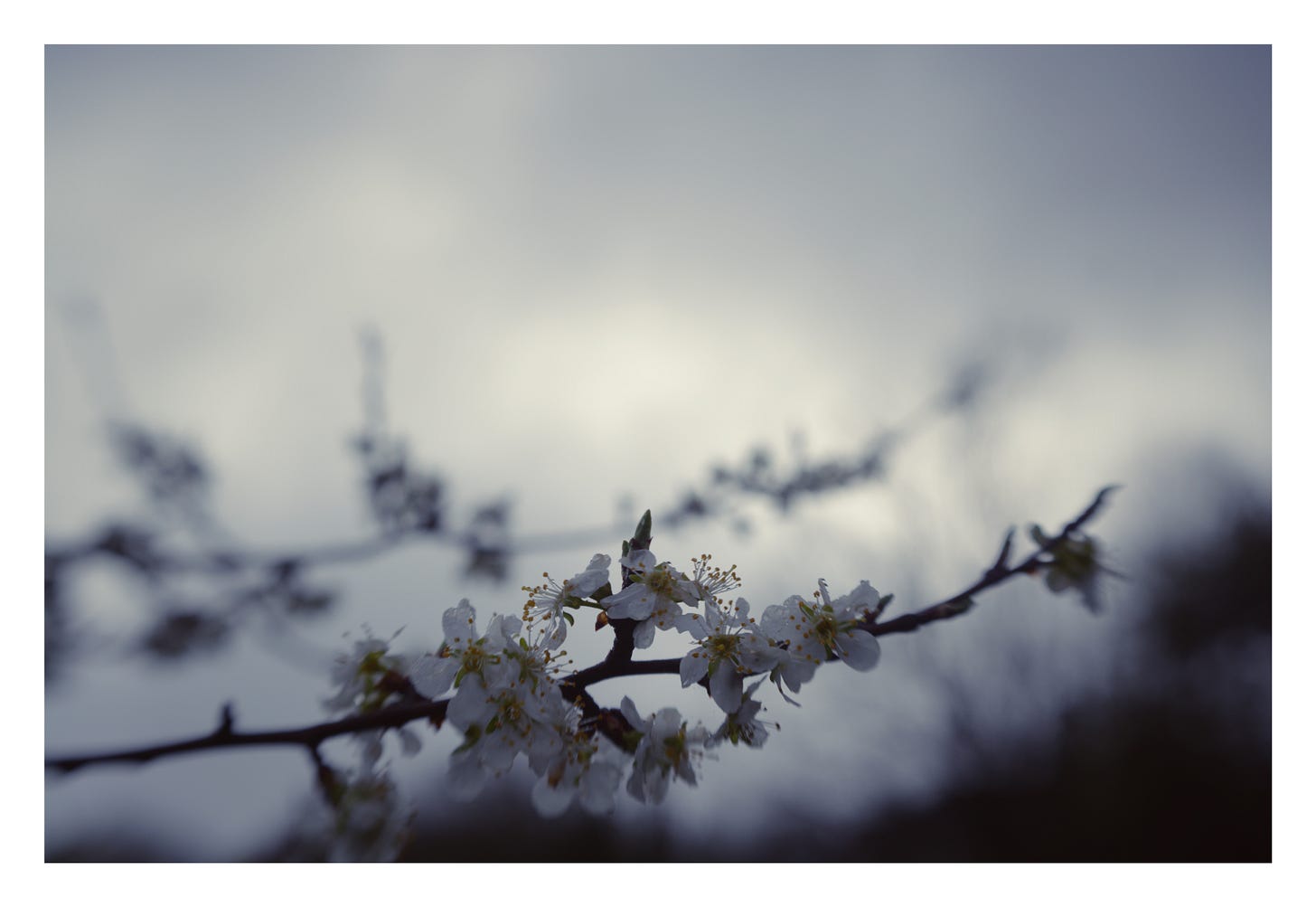After the driest and sunniest winter on record, the weather systems have changed direction and spring rains have at long last begun to fall. The sky has turned grey, a dark and foreboding gunmetal grey that looks as heavy as it feels and much needed rain falls in curtains across the landscape. It forms small rivers which run down the hill and straight across the completely inefficient drainage put in at the request of a neighbour blown in from ‘la Côte d’Azur’ (need I say more…) onto the lane and enters chez nous flooding our yard and the field below.
I welcome the rain for one reason only, because the soil is dry and it is necessary. The thought of the weeks ahead dashing constantly between showers, up to my ankles in mud, damp and sour smelling clothes strewn everywhere because there is nowhere left to dry them and muddy boots left in heaps, perfectly positioned to trip over by the door, does not fill me with delight; not even remotely. Frankly, I’m over it an hour after it begins!
The definition of spring fever in the Oxford dictionary is quite simply;
“a sudden increase in energy and the desire to go out and be active that some people have in the spring is a feeling of restlessness mixed with excitement”
for me though, it feels closer to cabin fever.
It has rained a lot over the last four days, deluge after deluge has ravaged the fruit trees, all of which are in full blossom. Another years harvest washed into the ground no doubt… The meadows, so parched and arid during the weeks prior though, are now living breathing organisms of life again. Colour returns in a flourish of luminous greens as spring flowers and leaves everywhere burst into life. I can almost hear the trees sighing in appreciation of the refreshing nourishment. A surge of nutritional gathering before the long, dry months of summer begin.
I try to use these changes to good advantage, a guidance for the day and week ahead. They either thrill me or fill me with apprehension.
I have never liked rainy days, not as a child and even less as an adult.
When I was a a young girl, before we moved to the house I grew up in during my turbulent adolescence, every Sunday morning I was forced into a taxi along with my middle sister to attend catechism lessons. I don’t ever remember the sun shining on those dreaded mornings, only a mad dash under coats and umbrellas to waiting transport; perhaps this memory is the latent reason for my absolute dislike of wet weather? Deep rooted connections floating subconsciously to the surface.
The primary instigator of our Sunday morning torture was my father, at least that was my belief. It was only in later years I realised that in fact, it was my French and very catholic grandmother who stood at the helm. In my ignorance though, every Sunday morning until the age of twelve, I hated my father. Strangely, by the time my younger sister (8 years my junior) was old enough to attend the lessons my dear papa, for whatever reason, had long since decided that the effort of trying to raise three indoctrinated angels was harder by far than accepting the free spirited angels we already were and she was never subjected to the horrors of the interior of the convent or it’s gloomy gardens, much less the nuns. Only myself and my middle sister harbour the memory and lasting impression of these long hours.
Notre Dame, was but a few minutes drive in the taxi from our home, though that journey lasted for what seemed an eternity to us. The sisters who drove us were mute. Whether by design or by vow, I never knew but not even a polite hello was offered, which did nothing to aid our general apathy. The two hours of excruciatingly long lessons we were about to embark on were typical of such an establishment during the early seventies; scriptures we neither understood nor had any desire to understand, prayers and silences that endured beyond comfort, an eternity for two young and usually so free spirited girls to endure. We may have been more attentive had we ever been asked to actually participate, to write an essay, or even answer questions. Although, on hindsight, both of us were enormously thankful that we didn’t actually have to make conversation, the silence was preferable by far. What could we have possibly said that would please after all?
The building, (now a bright and refreshed modern business centre), was imposing, hostile even. Inside was forever dark; a labyrinth of corridors, doors and stairways, all painted the same with a sickly green glossy paint. Presumably at one point it was to brighten the gloom but years of prayer and confession seemed to have diminished the colour to a dull khaki, it was grim beyond words. Had we ever been left alone, we would have been lost and terrified in seconds, mercifully we weren’t!
On every flat surface there were reliquaries containing hideous bodily parts of someone deemed important enough to warrant the title saint. Religious artefacts and paintings peered accusingly down at us from the walls and every windowsill, as if willing us with their piercing gaze to learn to accept their holiness. We looked at these monstrosities only once in all the years we were obliged to go, once was more than enough to have given us a lasting memory and a suspicion that religion was not all about being holier than thou! Lost souls seemed to speak in whispers everywhere, a haunting sound that echoed in every room like the sighs of the dead, or so we thought. I still hear those voices if I walk into a religious building even now, so much so that tears fall unbidden and uncontrollably from my eyes, though I can find no sensible reason for this. Yet strangely I am inexplicably drawn to these silent places of worship. The Abbey at Conques in the north of the Aveyron never fails to move me, neither the tiny and rapidly crumbling church in our local town at the bottom of the valley.
Surrounded by a high sandstone wall, the convent was almost hidden from view by a meticulously kept garden full of dark conifers and evergreen shrubs. I can still feel the prickles as goosebumps tingled on my skin the second we walked through the gates — the darkness of the closely clipped and shaped yew hedges, reminded me of the Edgar Allan Poe stories I loved to read with my mother, terrifying imaginings of ghouls and ghosts crowded my head and it took all my will power to not run the few short meters back to the entrance. I trembled at the thought of what could be hiding within the depths of such blackness, probably due to too much Edgar Allan Poe but there was no comparison; being frightened stupid when cuddled up to ones mother was altogether quite different from being scared stupid in what, to our minds, could quite conceivably be haunted gardens! These hedges, three times taller and five times wider than we were, formed, what seemed to us, a maze — the outside of which we would never see again should we dare to disobey. That garden never changed, not from one season or year to the next, always the plants that grew there were the same shape and the same colour, never a stray weed or a stone out of place on any one of the many paths. Almost as if it were a painted backdrop rolled down from the sky. We saw faces everywhere and yet never saw a single solitary soul working.
Now, when I recall the hours my sister and I spent in the company of the holy sisters at Notre Dame, the convent they inhabited, their holy relics, their devoutness and unwavering trust in the invisible god they worshipped, part of me envies such a deeply embedded belief, their ability to transcend reality. A form of escapism that was both frightening and fascinating and to me, for too long, completely elusive. I have spent many years, fruitlessly trying to replicate their faith. Patently, such a state of nirvana was something that not only took practice and patience but a belief in an entity that was entirely imaginary or at least for the most part, it is this that eluded me.
In my search to understand religion, I deduce finally, that it is personal. There are no rules; for each and everyone one of us a different meaning can be told or held. A place for the individual alone to discover. The sisters of the convent were content with their god and their sacred statues and paintings, their prayers and scriptures. To me it needed to be something far more tangible, a physical entity; living and breathing. I needed the ability to use all my senses, to hold it, catch the scent of it in the air, listen to its songs, it had to be visible, glorious or terrifying at the same time, for it to have any meaning at all.
And that which I could actually feel with all my senses was, I eventually discovered, (I guess I learn more slowly than most…) of course, nature. In all its elements, including rain in torrents, nature is sacred and worthy of worshipping — it appeared to me in the form of my hill. And I do think of it as mine, being the only human that walks its slopes every day, that knows every contour, that sheds tears of grief when a tree is ripped from its roots whether by strong winds or strong hands — these millions of tons of volcanic rock and stone with all its secrets and stories, this is the god I was searching for. It holds me in its grasp entirely and I live by its rules and predictions.
The French sociologist Emile Durkheim defined religion as a
“unified system of beliefs and practices relative to sacred things”.
I hesitate to say my beliefs are unified but they are relative - Here I have found all I need and above all else respect — and respect is certainly demanded. A deep understanding of its changes and moods, an ability to adapt and embrace each and every day; suffice to say I’m still learning, albeit slowly but there are days when I truly feel that state of being present or at least part of an entity far greater than I.
And, my god, induces song and dance… often.
“What I fear most, I think, is the death of the imagination. When the sky outside is merely pink, and the rooftops merely black: that photographic mind which paradoxically tells the truth, but the worthless truth, about the world. It is that synthesising spirit, that "shaping" force, which prolifically sprouts and makes up its own worlds with more inventiveness than God which I desire.“ — Sylvia Plath





You are finding your voice at last; love the smooth transitions!
Your story brings back memories of childhood. The time spent at a nuns school, peeking through the window to see the new knee high habits of the nuns and their new caps where you could see some hair! A priest coming over to school for lessons in religion - why couldn’t a sister do that? As I grew older the resistance to being forced to go to church on Sundays, the question why there was no place for women in church, other than in a serving role? And finally the transition to seeing nature as my kind of religion, but nonetheless the ongoing fascination for churches, convents and convent life. So thank you Susie, for sharing this story! 🤍🙏🏼